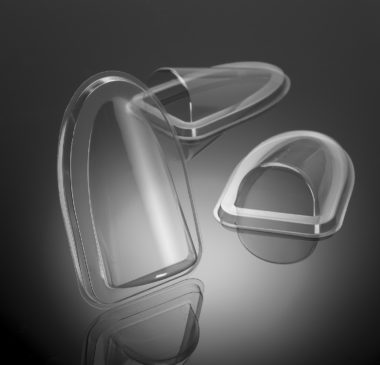Thermoforming Defined
Do you remember Shrinky Dinks®? Back in the 1980’s, Shrinky Dinks were a popular craft for kids made of flexible sheets of plastic or polystyrene. Children could cut the plastic into fun shapes, color them, and heat them in the oven to make their own key chains, earrings, pendants, stickers, and such.
The reminiscent term “Shrinky Dinks” came to mind when an engineer recently explained the thermoforming process. But thermoforming today is far more advanced. It’s like “Shrinky Dinks on Steroids,” with large sheets of plastic, an automated, high-temperature oven, metal forming tools to shape the plastic, and a die cutter or plastic trimmer.
Here’s a more technical definition: According to Wikipedia, thermoforming is “a manufacturing process where a plastic sheet is heated to a pliable temperature, formed to a specific shape in a mold, and trimmed to create a usable product.” In essence, the plastic sheet is heated in an oven so it can be stretched into or onto a mold and cooled into a finished shape or package. Thermoforming is responsible for creating the plastic component of many of the packages you see in retail stores.
What is the History of Thermoforming?
Interestingly enough, thermoforming got its start around the 1930-1940’s with a race to develop sturdy acrylic airplane canopies pre-World War II. According to researcher Stanley R. Rosen, E.L. Helwig of the Rohm and Haas Company (an acrylic resin manufacturer), and R.E. Leary of Dupont Corp. (one of the world’s largest producers of chemicals and science-based products), are two thermoforming industry pioneers.
In 1938, Helwig applied for a patent on the first thermoforming process. He used hot oil pressure to form and mold the acrylic and water to cool it. This is similar to a more advanced process used today to create high-quality packaging with air pressure and a temperature-controlled mold. A few years later, Helwig filed a second patent for a machine that created plastic packaging using a male snap-back clamp technique on the acrylic sheet after it was heated in an oven. Basically, he created the first “male-formed” plastic cavity with this thermoforming process.
R.E. Leary at Dupont wasn’t far behind. In 1940, he patented the first vacuum-forming machine using infrared bulbs to control the heat source on acrylic and achieve uniform wall thickness. Leary later developed a radiant heater assembly that could be raised or lowered relative to the plastic sheet. And the first thermoforming production line was born!
Thermoforming Today
Thermoforming has come a long  way since 1930 . . . it is much faster and produces higher quality plastic packaging today thanks to years of engineers perfecting the process. Now, a plastic sheet is quickly and efficiently transformed into a three-dimensional shape using heat, vacuum, and pressure techniques on an automated machine. There are over 200 brands of thermoforming machines, including Starview®, Sencorp®, Illig®, and others, using different plastic materials to create your thermoformed packages.
way since 1930 . . . it is much faster and produces higher quality plastic packaging today thanks to years of engineers perfecting the process. Now, a plastic sheet is quickly and efficiently transformed into a three-dimensional shape using heat, vacuum, and pressure techniques on an automated machine. There are over 200 brands of thermoforming machines, including Starview®, Sencorp®, Illig®, and others, using different plastic materials to create your thermoformed packages.
How We Create the Perfect (Plastic) Package at Rohrer
Now that you know a little more about what thermoforming is, the history of the thermoforming process, and how your plastic package can be easily developed using Rohrer’s state-of-the-art thermoforming machines, let’s get started!
The engineers and designers at Rohrer can create unique thermoformed packaging solutions, using a variety of plastic material types, depending on your product, your marketing goals, and your budget. Contact us today so we can create the perfect (plastic) package for you!



